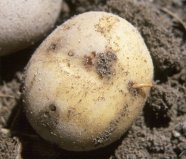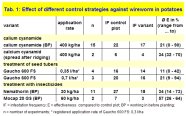Control of wireworms: a look back on ten years of experiments
Wireworms the larvae of Click beetles spread out quickly in areas of both conventional and organic farming. During their three to five year long development the larvae can cause great damage to underground parts of plants such as cereals, corn, root crop, leguminous and horticultural crops. As grassland is the natural habitat of the pest particularly many larvae can be found there. That is why after ploughing up of grassland or similar fields high damage rates can be expected in the following crops for several years.
In potatoes, wireworms tunnel into daughter tubers leaving narrow galleries. Such damaged lots can not be marketed as ware, processing or seed potato and are scarcely suitable for storage. Our experience has shown that increasing damage caused by wireworm has the following reasons:
- increased cultivation of cover crops and field forage respectively, leading to conditions comparable to grassland
- land set-aside
- increase of weeds in fields, especially of Agropyron
- straw remaining on fields
Field experiments: reducing damage by wireworm in potato production
As these causes supporting infestation will hardly change in practise, we carried out numerous field experiments during the past ten years aiming at the reduction of damage by wireworm in potato production. In detail these were:
- Calcium cyanamide (application rate 400kg/ha); in one variant the fertilizer was spread and incorporated in the soil evenly before planting potatoes, in a second variant it was spread after ridging.
- Treatment of tubers with Gaucho 600 FS (active substance: Imidacloprid) applying 0,35 l/ha and 0,7 l/ha. The insecticide is registered for treating tubers against aphids as viral vectors with 0,3 l/ha, a lower application rate than we used against wireworms.
- Treatment of the whole surface with insecticide granules. Once with nematizide “Nemathroin” (active substance: Fosthiazate) and once with Mocap 20 GS, which is no longer registered in Germany. Both products were spread and worked in evenly just before planting.
After lifting potatoes were assessed for damage by wireworms and infestation frequency was calculated. None of the tested variants showed promising results (see table 1). With an average of 57 % effectiveness Mocap 20 GS came off best. But it should be considered that the infestation rate of 7 per cent of the control plot was very low which usually forwards the effect strongly. Nevertheless this product is not registered in Germany any more and therefore can not be applied. The other variants did not get beyond an effectiveness of 34 per cent. The success of controlling wireworm varied strikingly from year to year. For example in 2000 infestation could not be reduced by Calcium cyanamide fertilizer nor by Gaucho 600 FS. Presumably weather conditions in spring are a decisive factor for control measures. During dry conditions (as in spring 2000) wireworms stay in deeper soil layers, so that they are not within reach of products applied. Similar problems can be expected when planting potatoes early, because larvae are still in deeper soil layers where they overwinter.
Controlling wireworm through crop rotation
A second approach, apart from control in potato crops, was controlling wireworm on one site during a period of a three-year crop rotation. For this purpose the seeds of the particular crop rotation components were treated with the active substance Imidacloprid for part of the field. This was “Gaucho” for maize, “Manta Plus” for cereals and “Monceren G” for potatoes, using the registered application rate for the different crops. At the end of the third year of experimentation wireworm infestation of potatoes was assessed. As shown in table 2 the use of Imidacloprid in all three crop rotation links reduced wireworm infestation on average by only 19% compared to the variant with non-treated seeds. The dissatisfying effectiveness is probably due to the repellent and not lethal effect of Imidacloprid on wireworms. Thus seeds and seedlings can be protected but the number of wireworms in the soil does not decrease. As the repellent effect only lasts for about 10 weeks while in potatoes it is important to protect daughter tubers, an effective control is not achieved without reducing the population.
Conclusion
Summarizing, results from the experiments show that the tested treatments for wireworm control offer only partial success at the most and in the near future the registration of new highly effective products is not likely. That is why for those working in this field it is essential to make the most from options available to keep damage as low as possible. These are:
- repeated stubble cleaning to damage eggs and larvae which are very sensitive to dryness, or to kill them mechanically
- regular test lifting (of 10 to 20 plants) to observe infestation degree of daughter tubers continuously; if the critical threshold for marketing is reached lifting at once is the only possibility to ensure quality and marketing
However, in sites with a high initial wireworm infestation these measures reach their limits. If it is not possible to switch to other crops less sensitive to wireworm growing starch potatoes is recommended.






